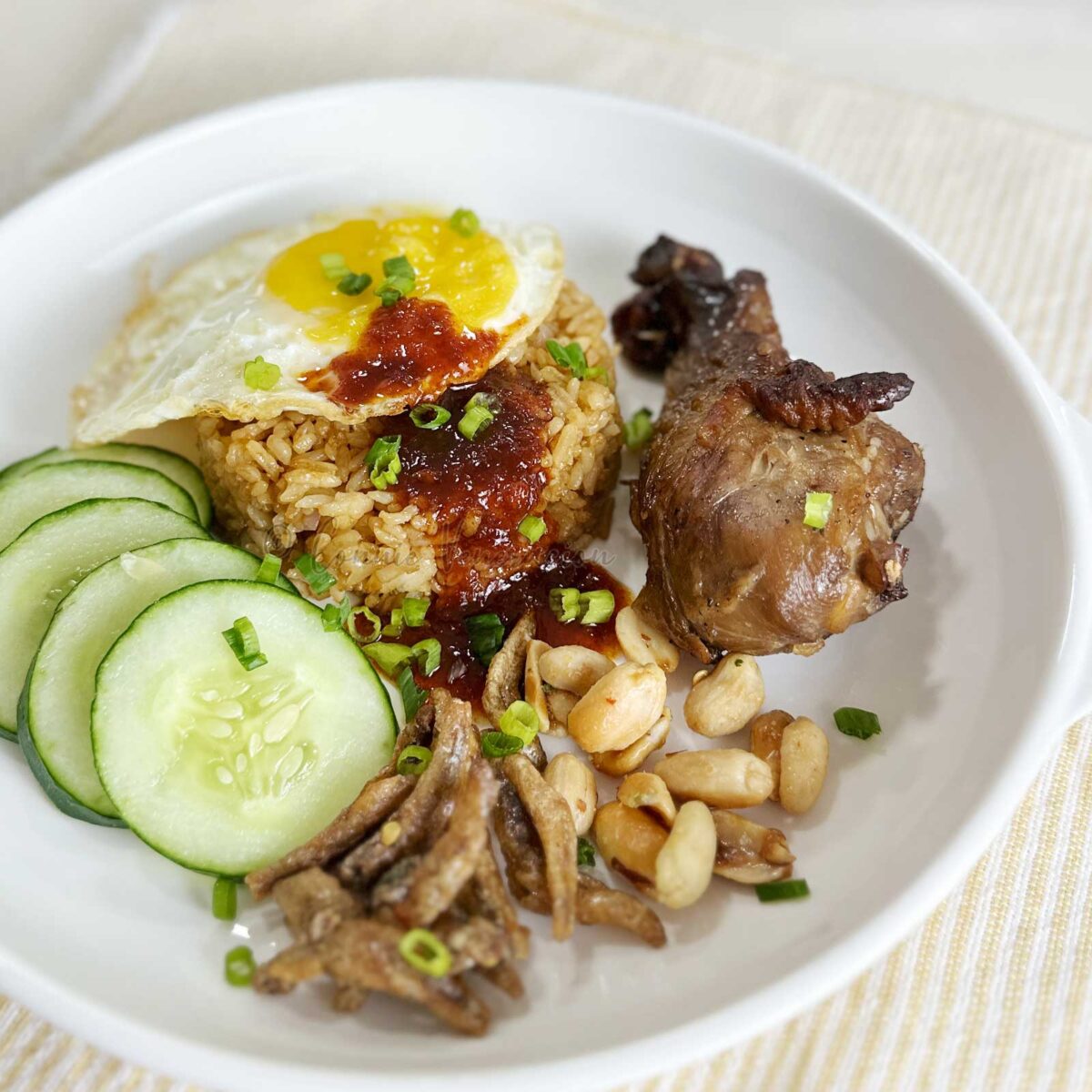Depending on who you ask, nasi goreng can refer to the fried rice or to the platter of fried rice, protein, vegetables and sambal.
I personally prefer to think of nasi goreng as just the fried rice and not the platter. Not only because nasi goreng literally translates to fried rice but also because just about anything can be served with the rice. Fried ikan bilis (anchovies), peanuts, egg and sambal sauce are almost always mainstays but the vegetables can vary and so can the main protein.
How is nasi goreng different from other Asian fried rice dishes?
The seasonings, mainly. Because there is shrimp paste in the dish, it has a strong umami flavor and aroma. Because there is tamarind paste in it, there is a subtle tanginess which is beautifully balanced by the salty-sweet kecap manis. And because there is sambal paste thrown in, nasi goreng can be spicy hot.
What is shrimp paste?
Difference between shrimp paste and shrimp sauce
In a nutshell, shrimp paste is a cooking ingredient while shrimp sauce is a condiment usually served as a dipping sauce. Here’s how they differ in appearance.
What is tamarind paste?
Note that tamarind paste is not the same as raw tamarind fruit. The paste is made by boiling tamarind pulp until it softens. The mixture is then strained and the soft pulp scraped to make the paste. While it is easy enough to make at home, you can buy tamarind paste in tubs in Asian groceries.
What is kecap manis?
It is a sweet soy sauce that originates from Indonesia. While the base, like other soy sauces, is soy beans, the addition of a generous amount of palm sugar gives it a syrupy consistency. The sweetness and thickness varies from one brand to another. Visit your local Asian grocery, see what brands are available, read the labels and check the amount of palm sugar in the sauce to give you an idea about the level of sweetness.
What is sambal?
Sambal is Indonesian chili paste with countless variants
Chili, or a combination chilies, is the ingredient for sambal, the Indonesian chili paste or sauce which is either cooked or raw. Secondary ingredients vary. Garlic, ginger, shallot, scallions, shrimp paste, lime juice and palm sugar may be added to modify the flavor of sambal.
How to cook nasi goreng

Start by sauteeing shallot, garlic and ginger. Do this gently over medium heat, stirring occasionally, until the shallot pieces start to soften. Add shrimp paste and fish sauce, and continue sauteeing until the edges of the shallot bits are starting to brown.

Add sambal and stir in. How much sambal? Well, if your tolerance for heat is high, a couple of tablespoonfuls will really pack in heat and give your fried rice a brighter color. But if, like me, you prefer subtle heat over the mouth-numbing kind, a tablespoonful will do.

Turn up the heat, dump in your day-old rice (it’s a bad idea to use newly cooked rice to make fried rice), pour in kecap manis and tamarind paste, and stir fry until the spices and seasonings are evenly distributed and the rice grains are all of the same color.

Your nasi goreng is fully done at this point but it never hurts to give it a taste and adjust the seasonings, if necessary, before serving.
Nasi goreng (Indonesian fried rice)

Ingredients
- 2 tablespoons cooking oil
- 2 shallots peeled and chopped
- 4 cloves garlic peeled and minced
- 1 half-inch piece ginger peeled and minced
- 1 tablespoon shrimp paste or use finely chopped dried shrimps
- ½ teaspoon fish sauce
- 1 tablespoon sambal (chili paste)
- 3 cups cooked rice preferably cooked the day before
- 2 heaping teaspoons kecap manis Indonesian sweet soy sauce (available in Asian groceries)
- 2 teaspoons tamarind paste available in Asian groceries
Instructions
- Heat the cooking oil in a wok or frying pan.
- Saute the shallots, garlic and ginger until softened and aromatic.
- Add the shrimp paste and fish sauce. Continue sauteeing until the edges of the shallot bits are nicely browned.
- Turn up the heat and add the rice. Drizzle in the kecap manis and tamarind paste.
- Stir fry until the rice is heated through.
- Taste the nasi goreng and adjust the seasonings, if needed.
- Serve your nasi goreng with egg, your preferred meat or seafood, ikan bilis, peanuts, vegetables, and more sambal.






